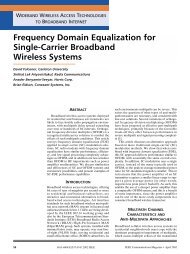Image Reconstruction for 3D Lung Imaging - Department of Systems ...
Image Reconstruction for 3D Lung Imaging - Department of Systems ...
Image Reconstruction for 3D Lung Imaging - Department of Systems ...
You also want an ePaper? Increase the reach of your titles
YUMPU automatically turns print PDFs into web optimized ePapers that Google loves.
which are explicitly:<br />
φ1 = 1<br />
2A {(x2y3 − x3y2) + (y2 − y3)x + (x3 − x2)y}<br />
φ2 = 1<br />
2A {(x3y1 − x1y3) + (y3 − y1)x + (x1 − x3)y}<br />
φ3 = 1<br />
2A {(x1y2 − x2y1) + (y1 − y2)x + (x2 − x1)y}<br />
(2.16)<br />
These newly defined functions are interpolatory on the three vertices <strong>of</strong> the triangle and<br />
are identical to equation 2.7 shown in the direct method <strong>of</strong> section 2.3.1. Each function, φi<br />
is zero at all vertices except one where it’s value is one:<br />
φi(xj,yj) = 0 i �= j<br />
= 1 i = j<br />
Equation 2.15 completely defines the potential within the triangular element as a function<br />
<strong>of</strong> the values <strong>of</strong> the potential at the element’s three nodes. In an analogous manner the<br />
linear interpolation functions <strong>for</strong> a <strong>3D</strong> model are derived in the next section.<br />
2.3.1.4 Derivation <strong>of</strong> Linear Interpolation Functions in <strong>3D</strong><br />
The potential within a typical tetrahedral element can be approximated by the linear function:<br />
U(x,y,z) = a + bx + cy + dz = � 1 x y z �<br />
⎡ ⎤<br />
a<br />
⎢ b ⎥<br />
⎣ c ⎦<br />
(2.17)<br />
d<br />
Thus the true continuous potential distribution over three space is modelled by a piecewise<br />
hyper-planar function U.<br />
The equation must hold at each node i where U = Ui when (x,y,z) = (xi,yi,zi) thus<br />
the coefficients a,b,c,d in equation 2.17 are found from the four independent simultaneous<br />
equations, which are obtained by requiring the potential to assume the values U1,U2,U3,U4<br />
at the four nodes. Substituting each <strong>of</strong> these four potentials and their geometric nodal<br />
positions into equation 2.17 yields four equations which can be collected to <strong>for</strong>m the matrix<br />
equation<br />
⎡<br />
⎢<br />
⎣<br />
U1<br />
U2<br />
U3<br />
U4<br />
⎤<br />
⎥<br />
⎦ =<br />
⎡<br />
⎢<br />
⎣<br />
1 x1 y1 z1<br />
1 x2 y2 z2<br />
1 x3 y3 z3<br />
1 x4 y4 z4<br />
⎤ ⎡<br />
⎥ ⎢<br />
⎥ ⎢<br />
⎦ ⎣<br />
a<br />
b<br />
c<br />
c<br />
⎤<br />
⎥<br />
⎦<br />
The coefficients a,b,c,d are determined by<br />
⎡ ⎤<br />
a<br />
⎢ b ⎥<br />
⎣ c ⎦<br />
d<br />
=<br />
⎡<br />
⎤−1<br />
⎡ ⎤<br />
U1<br />
⎢<br />
⎥ ⎢ U2 ⎥<br />
⎢<br />
⎥ ⎢ ⎥<br />
⎣<br />
⎦ ⎣ U3 ⎦<br />
1 x1 y1 z1<br />
1 x2 y2 z2<br />
1 x3 y3 z3<br />
1 x4 y4 z4<br />
Denote the inverse <strong>of</strong> the coefficient matrix by C which is<br />
⎡<br />
⎤<br />
C =<br />
⎢<br />
⎣<br />
1 x1 y1 z1<br />
1 x2 y2 z2<br />
1 x3 y3 z3<br />
1 x4 y4 z4<br />
⎥<br />
⎦<br />
−1<br />
U4<br />
= � C1 C2 C3 C4<br />
19<br />
� /det(C)<br />
(2.18)





